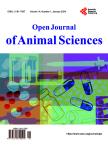Bovine trypanosomosis: A threat to cattle production in Chena district, southwest Ethiopia
Bovine trypanosomosis: A threat to cattle production in Chena district, southwest Ethiopia作者机构:Departement of Basic Veterinary Science Faculty of Veterinary Medicine University of Gondar Gondar Ethiopia Departement of Veterinary Paraclinical Studies Faculty of Veterinary Medicine University of Gondar Gondar Ethiopia
出 版 物:《Open Journal of Animal Sciences》 (动物科学期刊(英文))
年 卷 期:2012年第2卷第4期
页 面:287-291页
学科分类:1002[医学-临床医学] 100201[医学-内科学(含:心血管病、血液病、呼吸系病、消化系病、内分泌与代谢病、肾病、风湿病、传染病)] 10[医学]
主 题:Bovine Buffy Coat Chena PCV Prevalence Trypanosomosis
摘 要:A cross-sectional study to determine the prevalence of bovine trypanosomosis was carried out in Chena district, Kefa zone, southwest Ethiopia from September 2010 to January 2011. Blood samples were collected from 391 randomly selected local (zebu) breed cattle in three representative peasant associations (PAs). The buffy coat and Giemsa stained thin blood films examination techniques were used for parasite detection and identification. The packed cell volume (PCV) estimation was also conducted. From a total of 391 cattle, 6.9% (n = 27) of the animals were found positive for trypanosome infection. The trypanosome species observed across the study animals were T. congolense (4.89%), T. vivax (1.54%), and T. b. brucei (0.51%) as single infections. The infection rate of T. congolense and T. b. brucei varied significantly (P 0.05) in infection rate was found between male (7.79%) and female (5.62%) animals. The prevalence was 2.24% and 8.29% in young and adult cattle, respectively with significant difference (P 0.05) between them. The prevalence rate in good, medium and poor body conditioned animals were 7.28%, 0.78% and 13.39%, respectively with a statistical significant difference (P 0.05) among them. The mean PCV of the infected animals (17.56%) appeared significantly (P 0.05) lower than the non-infected (25.4%). Even if, the present study indicated a low prevalence of bovine trypanosomosis in the study areas, its impact on production and potential transmission to others should not be neglected.



